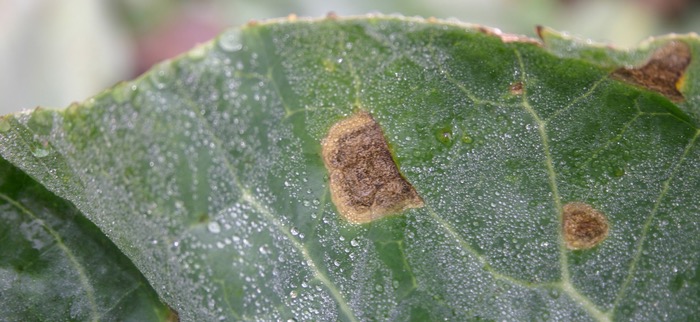The onset of heavy morning dews will seriously increase the risk of ringspot and White blister in brassica crops over the coming weeks. Crops have recovered remarkably well from the dry, slow growing conditions at planting, to now have good leaf canopies going into the autumn, reports Syngenta technical manager, Simon Jackson.
“The very dry conditions early in the season had significantly checked the initial incidence of ringspot, which often pops up through June and July and acts as a source of inoculum,” he highlighted. “However, with canopies now closing over and prolonged periods of leaf wetness from dew and heavy showers, pressure is building, and disease is taking off.”
Mr Jackson points out that when the first ringspot symptoms are identified, it’s a good indication that surrounding plants will have been infected. The pathogen’s lifecycle typically gives around five to seven days from initial spore infection to get a preventative fungicide onto the leaf to control symptoms occurring.
“Ringspot lesions left uncontrolled will quickly produce multiple infection points on surrounding plants. An Amistar Top application at the first sign of infection and when risk is increasing can protect the clean leaves and reduce pressure on productive new growth within the crop.” Older infected leaves soon wither and drop off the plant, he added.
Repeated warnings on disease forecasts
White blister only requires shorter periods of leaf wetness, compared to ringspot, so pressure has already been high, with repeated red warnings on the Brassica Alert disease forecasts, added Mr Jackson. An Amistar Top application timed to target white blister, is also effective on ringspot and other brassica leaf diseases, such as alternaria.
“Starting the season early, to prevent pressure building within the crop, gives the best chance to maintain green leaf area and crop quality right through to harvest. Amistar Top has always proven highly reliable and effective in the early autumn timings for Brussels sprout and white cabbage production,” he advised
The brassica market is currently being buoyed by strong order books from retailers, seeing high brassica demand for more cooking at home and an increase for frozen products, offering better value for money and reduced waste for consumers.
Broccoli deep freeze
Broccoli has been in particular demand for frozen processing. However, the key challenge for growers has been the incidence of systemic downy mildew, being especially evident as visible black staining when florets are broken up for freezing.
Mr Jackson advocates growers start a two-spray strategy with Revus, around five weeks post planting. “That’s primarily aimed at good control of systemic downy mildew at the earliest opportunity,” he advised.
However, many growers also comment that downy mildew appears to be a precursor of other later disease issues – primarily spear rot. “Targeting systemic downy mildew early with Revus can have a real season long benefit on overall broccoli head quality,” he added.
Furthermore, a follow-up application 14 to 21 days later with Amistar plus SL567A (available to broccoli growers as an EAMU) will provide good control of white blister and protect head quality.
Blister alert
“White bister is often slow to take off in the early autumn,” Mr Jackson pointed out. “But with more brassicas planted and levels of inoculum now in the environment, it will soon reach critical mass for widespread outbreaks. Putting Amistar Top strategies in place will be essential to protect leaf area and crop yields.”
Growers and agronomists can sign up for Brassica Alert now on the Syngenta website to receive advance warning of primary pest and disease issues: www.syngenta.co.uk




